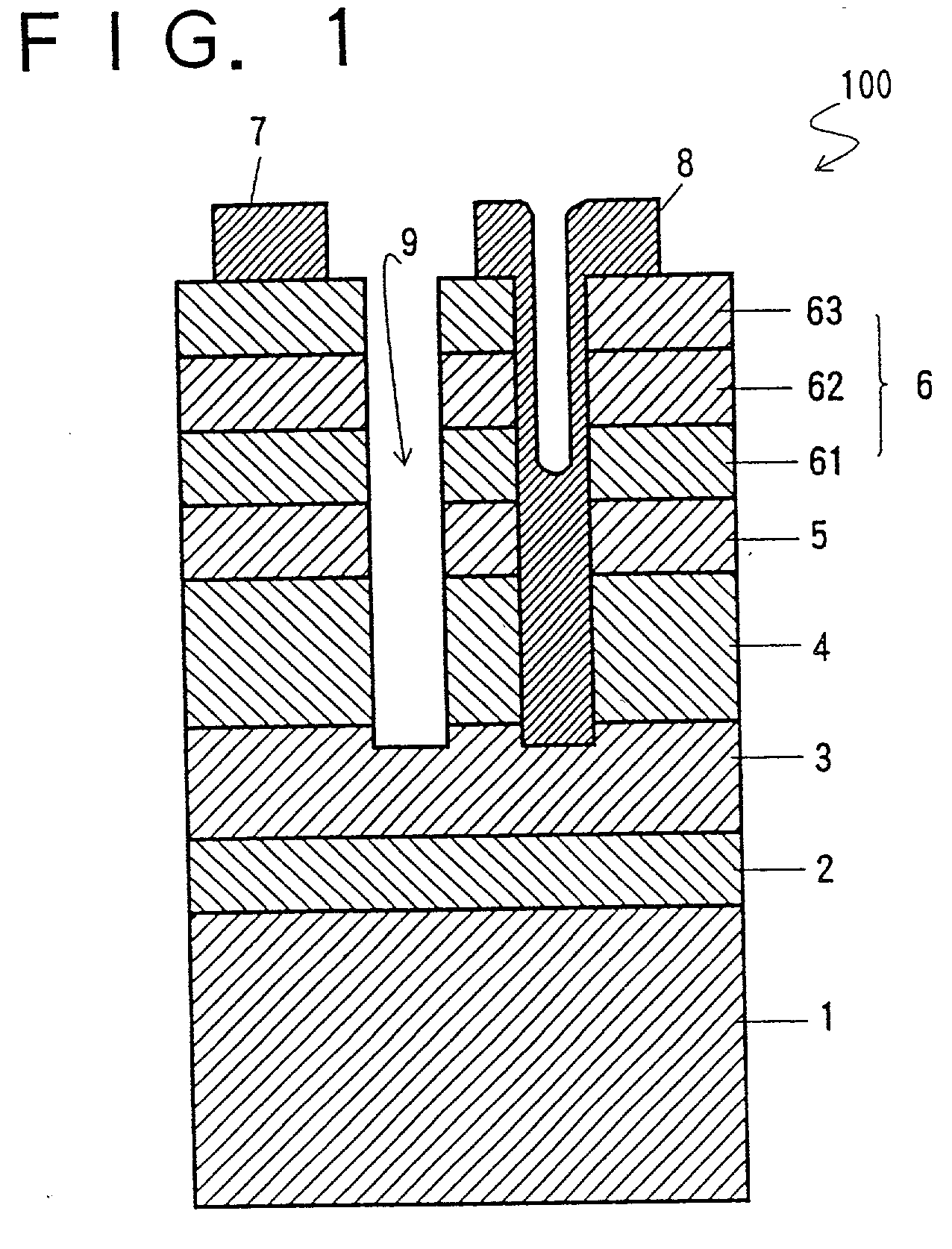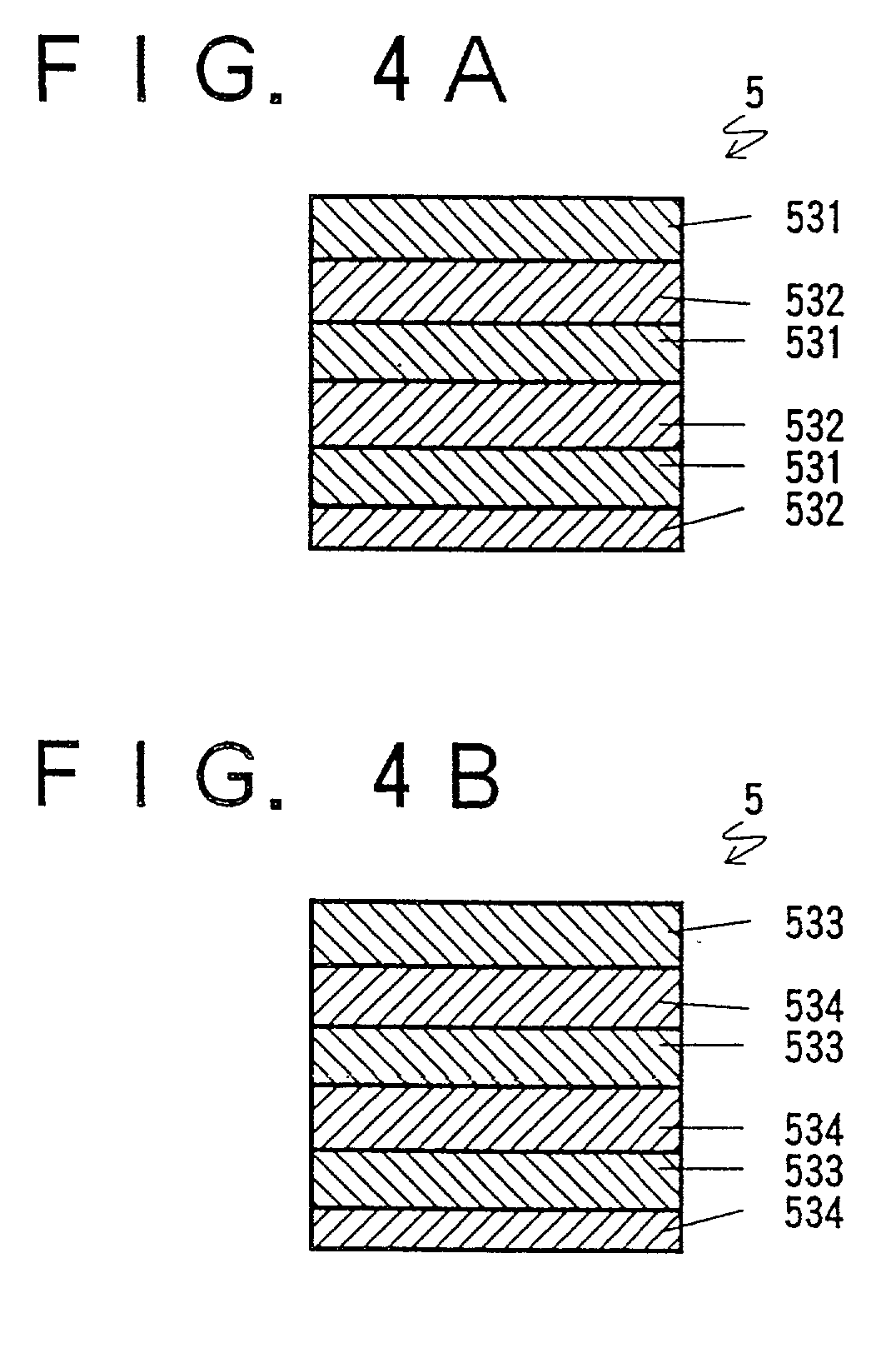Light-emitting semiconductor device using group III nitride compound
a technology of nitride compound and light-emitting semiconductor, which is applied in the direction of semiconductor devices, electrical equipment, and nanotechnology, etc., can solve the problems of not meeting the required 500 nm wavelength for traffic signals, unable to provide the required wavelength, and unable to obtain the required wavelength peak of 500 nm
- Summary
- Abstract
- Description
- Claims
- Application Information
AI Technical Summary
Problems solved by technology
Method used
Image
Examples
example 1
[0049] FIG. 1 shows an LED 100 embodied in Example 1, and FIG. 2 shows a layered structure corresponding to the LED 100 shown in FIG. 1, depicting a multi-layered emission layer 5 in more detail. It has a sapphire (Al.sub.2O.sub.3) substrate 1 upon which a 500 .ANG. in thickness of aluminum nitride (AIN) buffer layer 2 is formed. Consecutively, two n-type layers are formed on the AIN buffer layer 2: about 2.0 .mu.m in thickness of silicon (Si) doped GaN forms an n+-layer 3 of high carrier concentration having an electron concentration of 2.times.10.sup.18 / cm.su-p.3; and about 2.0 .mu.m in thickness of Si-doped Al.sub.x2Ga.sub.1-x2N forms an n-type clad layer 4 having an electron concentration of 8.times.10.sup.17 / cm.sup.3.
[0050] On the n-type clad layer 4, an emission layer 5 about 0.52 .mu.m in thickness and having a multi-layer structure, is formed as shown in FIG. 2. The emission layer 5 includes 13 A-layers 511 and 13 D-layers 512 which are made of magnesium (Mg) and zinc (Zn) d...
example 2
[0064] FIGS. 3A and 3B each show the structure of an emission layer 5 having a multi-layer structure in accordance with Example 2. The emission layer 5 of FIG. 3A has 25 A-layers 521 of Mg- and Zn-doped InGaN and 25 D-layers 522 of Mg- and Si-doped GaN, and that of FIG. 3B has 34 A-layers 523 of Mg- and Zn-doped InGaN and 34 D-layers 524 of Mg- and Si-doped GaN. The differences between the emission layers 5 of Example 2 and Example 1 reside in the thickness of its composite layers and the materials used to form those layers.
[0065] The layers ranging from the sapphire substrate 1 to the n-type clad layer 4 were prepared by above-described processes. As shown in FIG. 3A, about 100 .ANG. in thickness of Mg- and Si-doped GaN, layer 522 (D-layer), was formed as the lowermost layer of the multiple emission layer 5 on the n-type clad layer 4 under conditions controlled by keeping the temperature of the sapphire substrate 1 at 850.degree. C. and concurrently supplying for 2 min. N.sub.2 at ...
example 3
[0069] FIGS. 4A and 4B each show the structure of an multiple emission layer 5 in accordance with Example 3. The emission layer 5 of FIG. 4A has 25 A-layers of Zn-doped In.sub.0.08Ga.sub.0.92N layers 531 having a Zn concentration of 5.times.10.sup.18 / cm.sup.3 and 25 D-layers 532 of Si-doped Al.sub.0.1Ga.sub.0.9N having an Si concentration of 5.times.10.sup.18 / cm.sup.3, and that of FIG. 4B has 25 D-layers 533 of Si-doped In.sub.0.08Ga.sub.0.92N having an Si concentration of 2.times.10.sup.18 / cm.sup.3 and 25 A-layers 534 of Zn-doped Al.sub.0.1Ga.sub.0.9N having a Zn concentration of 1.times.10.sup.18 / cm.sup.3. The A-layers and D-layers were laminated alternately and repeatedly, each having a 100 .ANG. thickness. The D-layer 532 and the A-layer 534 are the lowermost layers. The entire emission layer 5 is about 0.5 .mu.m in thickness and the total number of its composite layers is 50. The other parts of the device were manufactured as described in Example 1.
[0070] The obtained LEDs with...
PUM
 Login to View More
Login to View More Abstract
Description
Claims
Application Information
 Login to View More
Login to View More - R&D
- Intellectual Property
- Life Sciences
- Materials
- Tech Scout
- Unparalleled Data Quality
- Higher Quality Content
- 60% Fewer Hallucinations
Browse by: Latest US Patents, China's latest patents, Technical Efficacy Thesaurus, Application Domain, Technology Topic, Popular Technical Reports.
© 2025 PatSnap. All rights reserved.Legal|Privacy policy|Modern Slavery Act Transparency Statement|Sitemap|About US| Contact US: help@patsnap.com



